#mica pottery
Text
Preliminaries: War of the Utility Wares!
Most pottery you find in archaeological sites isn't painted. Most pottery is unslipped, undecorated utility ware - with the assumption that "utility" typically here means "cooking over a fire." Sometimes grain storage. Usually cooking, though.
It doesn't mean they can't be beautiful in their own right. And one of my friends is working on a dissertation which among other things argues that "surface treatments" like incising and corrugation should be considered "decoration" too, when usually in archaeology "decorated" means "painted." There were lots and lots and lots of types of utility wares. Some were plain. Some were gorgeous.
So this is a Preliminary Round - four different styles traditionally called utility ware will go up against each other... only two will move on to represent utility wares in the final bracket.
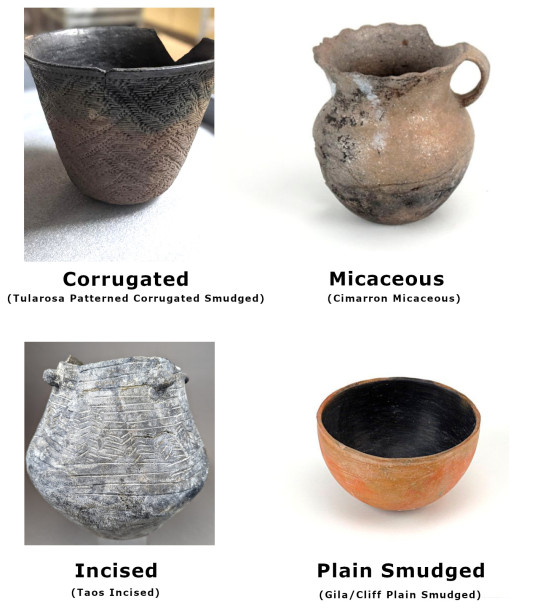
Vote for your favorite: More information about each is under the cut:
Corrugated
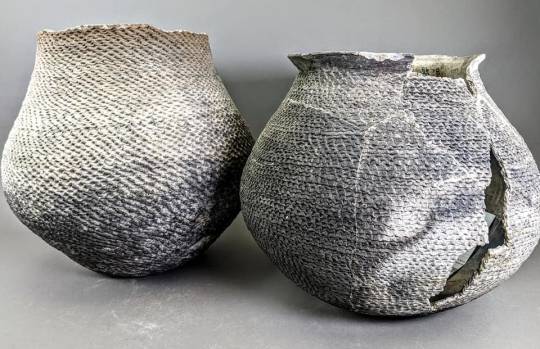
Mesa Verde Corrugated jars. Southern Colorado, AD 1100-1300.
There are SO many different types of corrugated pottery; if I listed them all we'd be here all day. However, they all have commonalities: They were primarily (though not exclusively) made in the Mogollon cultural region, primarily (though not exclusively) plain and unpainted, and primarily (though not exclusively) used for cooking.
In this region, potters don't use pottery wheels. Pots are hand-built, typically from coil-building: using many thin coils to build up the shape of the pot. For most pots, those coils are scraped smooth as they're still wet. But for corrugated pots, those coils are only scraped smooth on the inside. The outside coils are instead pressed using a tool or the potter's thumb to make a patterned, scaled, or woven texture. Corrugation, due to its association with cooking pots, is not typically considered "decoration" by archaeologists, but it creates beautiful and captivating patterns.
Micaceous

Micaceous Bowl with Etched Flowers. Made by Virginia Romero (Taos Pueblo, 1896-1998).
In northern New Mexico, there are golden-red clays with a lot of sparkly mica in them. The mica self-tempers the clay, and creates a lovely shimmering effect when you see the pots in person. There's evidence of polished micaceous pottery being made as early as the 1300s, but it really took off as a popular type of cooking ware in the 1500s-1600s. In this time, it was made primarily by norther Pueblos like Taos, Picuris, and Nambe, but was enthusiastically adopted by the Jicarilla Apache as well, who have strong social ties to those northern Pueblos. Cimarron Micaceous, the handled jar seen above the cut, is a 1600s Apache micaceous pottery style.
Micaceous pottery is still extremely popular with Native potters today. Some of it is as an art form, with many different experiments in structure and style, but some people still swear by cooking in these micaceous clay pots - beans just taste better when cooked in clay instead of metal!
Incised

Taos Incised jar sherd. Northern New Mexico, AD 1050-1300.
Incised ware is SO underappreciated. However I am also biased because for the past three or four summers I have worked on an archaeology project in the Taos area and we find so much of it.
Incised designs are carved into the wet clay. Usually, these are not painted. Incised pottery is very common on the Great Plains, but less so in the Southwest. The Northern Pueblos like Taos and Picuris, however, has long-standing interactions with Plains groups, trading corn and buffalo hides, holding market days together, Picuris and Taos people fleeing the Spanish invasion to live in Kansas with their Apache allies. This is also visible in the sharing of pottery styles in the northern Pueblos, where incised ware is common. Parallel lines that mimic corrugation, chevrons, and herringbone patterns are common.
Plain Smudged
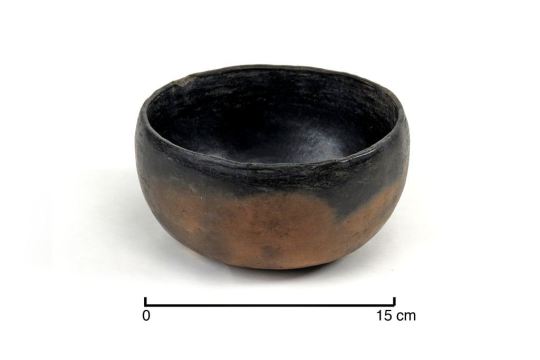
Reserve Plain Smudged, Mogollon Highlands, AD 600-1250.
As I described in my pottery jargon post, "smudging" is a method of getting that shiny black interior during the firing stage. During firing, different levels of oxygen will cause the minerals in the clay to turn different colors. An oxidized environment (high oxygen) turns iron-rich clays red; a recducing atmosphere (restricted oxygen) plus an infusion of carbon turns them black. To smudge a pot, the inside is polished, and then in the firing pit is covered with ash and charcoal. This puts a lot of carbon on the surface, and blocks the oxygen from reaching it. When the pot comes out of the fire, the part that was covered in charcoal will be shiny black. This was another pottery style particularly popular in Mogollon areas.
47 notes
·
View notes
Text

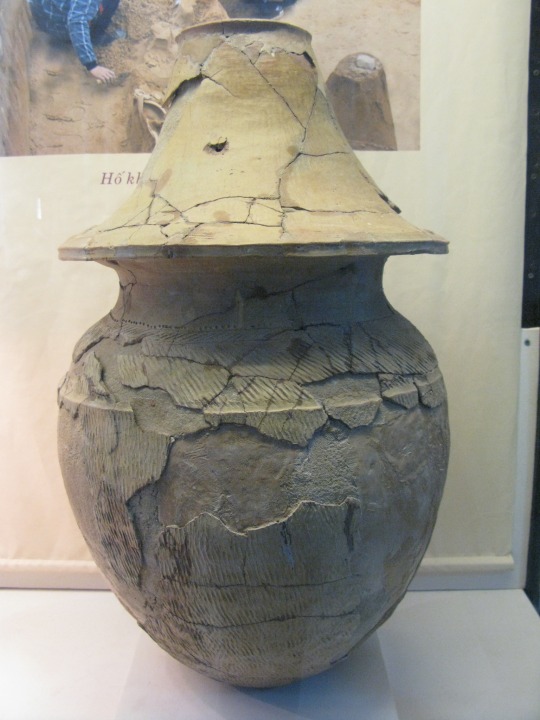
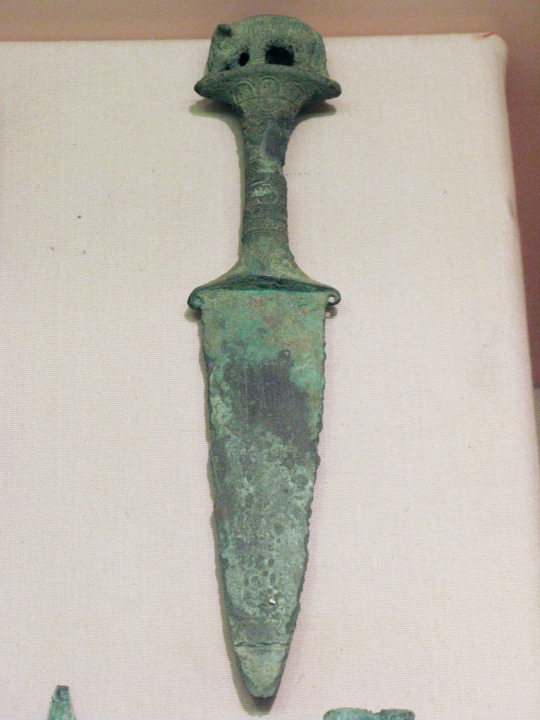
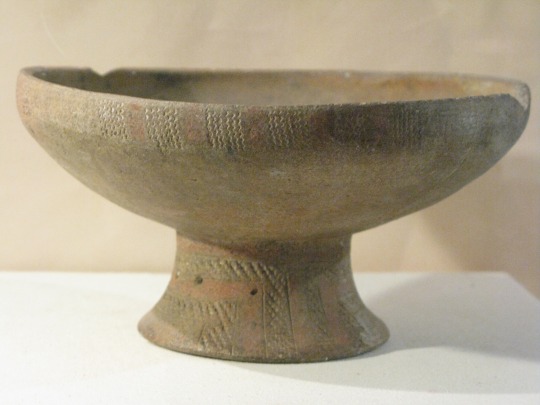
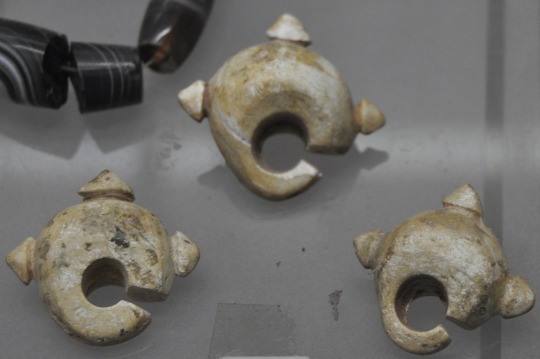
From left to right, top to bottom: pottery vase; burial jar; bronze weapon; clay fruit tray; and jade lingling-o. Photos #1–#4 by Bình Giang, 2009. Photo #5 by HappyMidnight, 2012. All photos taken from Wikimedia Commons.
Artifacts of the Sa Huỳnh culture. This culture originated in modern-day Vietnam and flourished between 1,000 BC and 200 AD. Due to early trade networks, the Sa Huỳnh culture had spread across Taiwan and Southeast Asia.
On the trade network, according to Wikipedia:
The Sa Huỳnh culture showed evidence of an extensive trade network that existed between 500 BC to AD 1500, known as the Sa Huynh-Kalanay Interaction Sphere (named after the Sa Huỳnh culture and the Kalanay Cave of Masbate, Philippines). It was mainly between Sa Huỳnh and the Philippines, but also extended into archaeological sites in Taiwan, Southern Thailand, and northeastern Borneo. It is characterized by shared red-slipped pottery traditions, as well as double-headed and penannular ornaments known as lingling-o made from materials like green jade (sourced from Taiwan), green mica (from Mindoro), black nephrite (from Hà Tĩnh) and clay (from Vietnam and the Northern Philippines).[5] Sa Huynh also produced beads made from glass, carnelian, agate, olivine, zircon, gold and garnet; most of whom use materials that are also imported. Han dynasty-style bronze mirrors were also found in Sa Huynh sites.[5][6][7]
11 notes
·
View notes
Note
Research has also linked older paternal age to declines in sperm quality, meaning the squiggly little gene packets that contribute half of a baby's DNA are more likely to be affected by DNA fragmentation, abnormal chromosome numbers, new mutations, and epigenetic alterations.
"Overall, the accumulation of alterations in older men may increase the risk of conditions like autism, pediatric cancers, achondroplasia, and schizophrenia; decrease likelihood of ART success; and heighten risk of perinatal complications," the authors write.
yeah i agree geriatric men shouldn't be allowed to reproduce bc their degrading sp*rm results in fetuses with deficiencies. men probably peak at like 25 and it's downhill from that
you really should like at least include a link to the original post that made you send it to me bc i have no idea why are you even telling me this
and i don't really care that much




here anon look at gorgeous uzbek white semi translucent flint which shines in the light, kind of like pottery with mica admixture. its a beautiful beautiful levallois blade

and some Tien Shan mountains for you
6 notes
·
View notes
Text



Blue Spot Pottery
This trade set was based on a set of pottery the trader had for her wedding! A mix of white pigment paste and cream Mica powder with creamy navy blue spots on some faces.
#resin dice#dungeons and dragons#dice#dnd#dice maker#dnd dice#dungeons and dragons dice#handmade dice#resin artist#custom dice#dice photography#rpg dice#click clacks#math rocks#the folded crane dice#ttrpg#ttrpg dice#tabletop dice
85 notes
·
View notes
Text
Finally starting something I've been meaning to since covid. Okay, a lot longer bit this time I'm cheating and using a diy kit.
Kintsugi, for those unfamiliar with the word, refers to the Japanese art of pottery repair with lacquer and gold/silver dust. The idea is the break and repair is part of the item's history and highlighted.
My lacquer is doneskies and needs replaced, and while I have silversmith experience for blade ornaments... well I'm poor.
So this is more epoxsugi? Practicing on a broken kitchen jar lid. Come follow me on this journey as I huff glue fumes and mica (myka?) powder... I mean fix this lid.

2 notes
·
View notes
Text

¿Tesoros turísticos? Cazuelas, Puente del Inca, Mendoza, 2022.
While these were being sold in a market where other stalls were catering to tourists, the presumed special clay containing quartz and mica used to make these bowls may result in useful household objects. Did not buy one as we were at the beginning of our trip, and pottery is heavy and not all that durable in luggage.
#tourist treasures#souvenirs#olla#special clay#puente del inca#mendoza#argentina#2022#photographers on tumblr
12 notes
·
View notes
Text
The Great Lakes region—including the Ohio River valley, the area around the lakes themselves, and the Mississippi basin up to the edge of the Great Plains—was home to some of the bloodiest fighting and also some of the most aggressive and effective Indian resistance to colonization on the entire continent.
Our present mapmaking turns the lakes into a border between the United States and Canada, an upper limit, rather than the crossroads that they were. Moving from south to north, the Mississippi River and its twin tributaries—the Missouri and the Ohio, draining the west and east, respectively—point like a trident at the belly of the lakes. The lakes themselves draw water from as far west as northern Minnesota and bring it all the way to the ocean. To the north of the lakes, great rivers like the Rainy, Hayes, Severn, and Albany feed north into Hudson Bay and beyond into the Arctic. Seen this way, the Great Lakes and the land that rises on their northern and southern flanks are the confluence of a vast network of waterways. For Indians as far back as the Paleolithic they were the hub of the New World.
Migrating waterfowl, fish, and game have followed these waterways since the end of the last North American ice age twelve thousand years ago. The earliest Native peoples, who lived alongside the game on which they depended, used these waterways, too. By the beginning of the Woodland period in 500 BCE there was a vast cultural and technological network that followed the water, spreading knowledge along with the cultures that carried it. The use of the bow and arrow, pottery, plant domestication, architecture, and burial practices flowed from the Gulf of Mexico all the way up to north of Lake Ontario and back again. In the various climates found in this vast and fecund area native plants, including gourds, sumpweed, goosefoot, sunflower, knotweed, little barley, and maygrass, were cultivated long before the arrival of corn and beans. In the Middle Woodland period, what is known as the Hopewell culture (also called the Hopewell complex or Hopewell exchange network) arose. The Hopewell cultures typically made their homes in or near oxbows and floodplains that seasonally replenished rich planting grounds, aquatic food sources, and waterfowl. The villages could reach significant size and were surrounded by mounds of all shapes and sizes that were one of the hallmarks of the culture. The Hopewell Ceremonial Earthworks near Chillicothe, Ohio, for example, measures 1,254 feet long and connects thirty-eight mounds within an earthen rectangle measuring more than one hundred acres.
Most, but not all, mounds contained burials of staggering richness. (The purpose of many effigy mounds—like the Great Serpent Mound, southeast of Chillicothe, Ohio, the largest effigy mound in the world—remains unknown or, at the least, hotly debated among archaeologists.) The mounds themselves were constructed using large poles that supported a thatched roof. The deceased were placed inside the shelter and buried with an abundance of trade goods. In Ohio some mounds were found to contain thousands of freshwater pearls, mica, tortoise shells, Knife River flint (from North Dakota), and conch (from Mexico). The finds indicate that these communities were both well-off and well-connected. Around the burial structure, heaps of animal bones suggest that the dead were feasted in fine fashion by their relatives. After the feasting, the gathered goods were burned down and covered over with earth. Along with larger villages and greater economic and caloric security came an explosion in artistic expression. Hopewell Indians were expert carvers. One burial mound at the Mound City site in Ross County, Ohio, contained more than two hundred intricately carved smoking pipes.
But around 500 CE, the Hopewell exchange network, along with the large villages and the mound building, disappeared. So did the artwork. Populations seem to have gone into decline. No one knows why, exactly. Trade and commerce brought goods from all over the continent, but they might also have brought war: some villages from the end of the period were bounded by moats and wooden palisades. The climate grew colder, which may have made game grow scarce. Likewise, improvements in hunting technology may have caused a collapse in animal populations. Agriculture itself may have been a culprit: as of 900 CE, maize and beans were well established throughout the region, and the rise of agriculture could have generated a shift in social organization. Much later, the Mississippian period, from 1100 to 1541 CE, saw the advent of the bow, small projectile points, pottery, and a shift from gathering to intensive agriculture. Large villages replaced small seasonal camps. The largest Mississippian village was surely Cahokia, which was at its peak around 1050–1250 CE, situated at the confluence of the Mississippi and Missouri Rivers near present-day St. Louis, spreading over five square miles and with a population estimated to reach thirty thousand. One burial site there contained twenty thousand shell beads, another eight hundred arrowheads. That, too, went into decline and was abandoned. Whatever the cause, by the time Europeans arrived in the region in the mid–seventeenth century, Cahokia and similar settlements had been long abandoned.
While tribes in the Southeast, Southwest, and Northeast were involved in countless local struggles (and not a few large ones) with the Spanish, English, Dutch, and French, Indians west of the Appalachians had at first only fleeting contact with the newcomers. But as happened elsewhere, harbingers arrived first, in the form of trade goods and disease. Some of this arrived with waves of tribal newcomers as refugees from the coastal groups headed inland, sparking territorial conflicts well west of the Atlantic even before Europeans set foot in the contested territories. The political disruptions caused by masses of refugees were compounded by disruptions to seasonal hunting and gathering cycles brought on by disease. The time and energy it took to weave nets, knap spear and arrow points, set traps, spear fish, and weave material was lost to war, illness, and death. Native technologies had already evolved that were well suited to the worlds of the Indians who invented them, yet what was wanting were specialists to make and use that technology. European knives were no better at cutting. European axes were no better at felling. In the chaos of the times, it became expedient to trade for them rather than to make them. The increased reliance on European trade goods in turn caused more geopolitical conflict.
In times of upheaval as in times of strife and instability, the region was defined by its prehistoric routes and cultures. Jacques Cartier, exploring the Gulf of Saint Lawrence in the 1530s and early 1540s, did ship-side trading with Natives there, exchanging knives and kettles and the like for fur used in trim—unaware of the wealth waiting to be extracted from the Pays d’en Haut (Upper Country) in the form of beaver pelts. According to Cartier, the Indians he met “made frequent signs to us to come on shore, holding up to us some furs on sticks. . . . They bartered all they had to such an extent that all went back naked without anything on them; and they made signs to us that they would return on the morrow with more furs.” Basque fishermen—present since the 1490s—became deeply enmeshed in the beaver trade. Seasonal fishermen, operating on the Grand Banks as early as 1512, traded metal items for beaver furs, which would be sewn into robes to keep the sailors warm during their endeavors and then be sold back in France. It wasn’t long before beaver fur’s unique felting qualities dramatically increased European demand for it (the barbed strands clung to one another with extraordinary strength). This led to an increased focus on exploration into the Gulf of Saint Lawrence, and the returning reports of a vast continent loaded with furs and Indians eager to trade drove Europeans deeper still into the interior, with a predictable increase in conflict.
The Iroquois Confederacy maintained a stranglehold on travel into the interior via the Great Lakes waterways, which meant, in the middle to late sixteenth century, control over all the trade in the region. Unlike the loosely affiliated Algonquian tribes and nonaffiliated Iroquoian tribes such as the Huron, they had access to trade goods: metal traps, kettles, axes, blankets, guns, shot, powder, and knives. Such items conferred a decided military advantage, and between the end of the sixteenth century and the full blossoming of the fur trade, the Iroquois were engaged in endless wars of advantage with their tribal neighbors to the east. They also managed to negotiate punitive trade deals with the French along the Saint Lawrence and the English down the Hudson.
The tribes to the west of the Iroquois were numerous and powerful but spread out over a vast territory. They included the Shawnee, Odawa, Potawatomi, Ojibwe, Sac, Fox, Menominee, Ho-Chunk (Winnebago), Osage, Miami, Dakota, Cree, Mandan, Arikara, Hidatsa, and Huron (to name but a few). With the exception of the Huron, who lived in large agricultural settlements on the north side of Lake Ontario and later near Georgian Bay and whose population numbered 20,000 to 40,000 or more, western Great Lakes tribes were broken into small mobile villages of around 150 to 300 people, organized by kinship ties. These were the Indians of storybook legend: plying the vast woodlands in birchbark canoes and treading the hushed forests in moccasins. They were primarily hunter-gatherers, though they, too, grew corn, beans, and squash. More westerly tribes such as the Ojibwe had also begun harvesting and cultivating naturally occurring wild rice—a swampy aquatic plant in the oat family that provided a very stable and nutrient-rich food source.
In 1608, Samuel de Champlain (the “father of New France”) pushed deeper into the Saint Lawrence and landed at the site that would become Quebec. As historian Michael McDonnell notes, Quebec was less a colony of settlement than the site of a warehouse and trading factory. Trading posts or factories—which in no way resembled factories as we know them—were combination free-trade zones, consulates, military garrisons, and settlements. European and American goods would be brought there, while Indian trade goods (usually furs and buckskin) were brought from the interior. The factory would be run by a “factor,” essentially a trader, and staffed with other traders who worked under him, along with craftsmen with needed skills, such as blacksmiths and tanners.
The hope at Quebec was to catch furs coming out of the northland and thereby bypass the British to the east and the Spanish creeping up the Mississippi from the south. The French mode of settlement was for Indians in many ways preferable to that of the British and the Spanish. Instead of following a pattern of conquest, subjugation, settlement, and displacement, the French, preferring to trade rather than to settle, were much more inclined to adapt to the new country and its inhabitants. The new outpost was deep in Indian country, and to survive it needed the help of its neighbors. The French began trading with the Huron: metal goods and guns in exchange for stores of surplus corn. The Huron maintained good trade relations with their Algonquian neighbors, the Odawa and Ojibwe, so that, while they themselves did not have access to furs, they had access to and good relations with those who did. A year after Champlain landed at Quebec, the Huron were trading with the French vigorously, then trading with the Odawa and Ojibwe in turn. It wasn’t long, however, before Champlain recognized that in order to get premium northern furs (and at a better price), he had to deal directly with the Odawa and Ojibwe.
As they say: Location, location, location. At this time the Odawa and Ojibwe (Anishinaabe) were located around Michilimackinac, which sat at the straits that separated Lake Michigan from Lake Huron, a day’s paddle from the outlet of Lake Superior and perhaps the most strategically important location in North America at that time. Control the straits and you controlled travel and trade for the majority of the continent. The location also suited the cultural prerogatives of kinship unique to the Algonquians of the region: they were principally exogamous and had a very well developed clan system. Children took the clan of their fathers and typically married out of their village into nearby villages and even other tribes. The son would move out of his family’s home and into that of his wife, bringing with him his clan and sense of relatedness. As a result, “family” became a large thing indeed and pulled populations of mobile and separate tribes into incredibly durable and mutually beneficial relationships over great distances. This well-woven network was an incredible boon in times of war and matters of trade. Moreover, Michilimackinac offered access to reliable food sources. The lakes in all directions mitigated the effects of latitude with a microclimate that allowed for corn production well north of its usual limit and supported an incredible diversity of plants and trees. Ash, oak, maple, elm, spruce, cedar, and white pine grew in profusion. The fall spawn of whitefish was said to be so intense that one could walk across the straits on the backs of the spawning fish. Villages tended to be seasonal and small—groups of usually no more than 150 relatives who lived in largely single-family wigwams, made from saplings driven into the ground and bent and tied together into a dome shape, then covered with woven reeds, cedar bark, birchbark shingles, or elm bark. These populations shifted between winter hunting grounds, spring fishing sites, sugar bush, and summer berrying locations. In summer, when insects were at their worst, villages shifted to high bluffs or rocky promontories to catch the breeze. In winter, when temperatures dropped below zero, as in the Northeast, families often consolidated into larger oblong wigwams or lodges to conserve resources and heat.
In this way the Great Lakes Indians made the most of their homelands in the heart of the heartland. They also had the benefit of timing: they were there at the beginning of the seventeenth century, when the fur trade blossomed into the first—and for centuries the most important—global industry. Their strong position allowed the allied Anishinaabe tribes (Odawa, Ojibwe, Potawatomi) to pressure the French to supply more than trade goods if they were going to be suffered to stay in the Pays d’en Haut. In 1609, they coerced the French into joining them in war parties against the Iroquois Confederacy, who were a constant threat on the southeastern flank of the Great Lakes. And so began a well-regulated pattern of trade.
By the late seventeenth century the Anishinaabe allowed the French to build forts and trading posts as far north and west as Michilimackinac itself, sustaining a seasonal cycle of trade in Indian lands. The French followed Ojibwe and Odawa trade terms and their cultural protocols for feasting and gift-giving. When they failed to comply or tried to dictate new terms, the Anishinaabe would court the British and trade with them until the French fell back in line. With such leverage, the fate of the Great Lakes Indians came to differ radically from that of Indians in tribal homelands everywhere else in North America. Even during the French and British conquest of the Great Lakes, and disease notwithstanding, the population of Algonquian tribes such as the Odawa, Ojibwe, and Potawatomi boomed, quadrupling between 1600 and 1800. The land base of the northern Algonquians expanded by a factor of twenty. Material culture, arts, and religion flourished. The strategic alliances and balance of power that inspired this “golden age” were nowhere more in evidence than in the attack at Pickawillany in 1752.
The French, after early successes in the seventeenth century, had been losing (globally and in North America) to the British. Piankashaw chief Memeskia, having grown dissatisfied with French trade goods and the French themselves, formed an intertribal coalition and began attacking the French. Many disaffected bands and individuals joined him. They formed a village at Pickawillany (at present-day Piqua, Ohio). They welcomed the British and allowed them to build a garrison and trading post nearby. Memeskia was becoming formidable, and his pan-Indian alliances threatened the balance among European powers so crucial to continued Indian control of the Great Lakes. If the British and French were kept wrong-footed, neither could consolidate their power and expand. With that in mind, the Anishinaabe played to their strengths and engaged in some furious diplomacy with their allies and their enemies. They warned the British that they were going to attack them in a general war. And they traveled from Michilimackinac by canoe to meet with the Onondaga Iroquois far to the east. The Iroquois Confederacy claimed the land in Ohio as their own, but they were in a tough place: they were allied with the British, and the British were trading and working with Memeskia. They gave the Algonquians their tacit blessing to remove Memeskia and his people, saying that they would “not permit any Nation to establish posts there; the Master of Life has placed us on that territory, and we alone ought to enjoy it, without anybody having the power to trouble us there.” In other words, they would not clear out the offenders, but they gave the Algonquians leave to do so.
In the winter of 1751–1752, Charles Langlade, a young mixed-race Odawa-French leader, began assembling a war party of Odawa, Potawatomi, and Ojibwe warriors who traveled by canoe south to Detroit and then upriver and over land to Pickawillany. They attacked the village in mid-morning on June 21, 1752, when the women were in the fields, and killed thirteen Miami men and captured five English traders. The survivors of the first assault fled back to a rough stockade, where Langlade and the Anishinaabe warriors fired on them for the better part of the day. Eventually the Miami, down to twenty or so warriors and low on water, tried to negotiate terms of surrender. Langlade said he wanted submission, not defeat, and said the survivors could leave if they promised to return home and if they handed over the English. The Miami failed, however, to honor the agreement, sending out only three of the five Englishmen. When they reached Langlade’s lines his men set on one of them, “stabbed him to death, scalped him, and ripped his heart out. They ate it in front of the defenders.” Then they seized Memeskia himself. They ordered the remaining defenders to stand and watch as they “killed, boiled, and ate Memeskia in front of his family and kinsmen.” Afterward, they released the Miami women they had captured and left for Detroit with the four captured Englishmen and more than $300,000 (in today’s money) of trade goods. This frontier victory against the English set off the First Anglo-Indian War, helped to ignite the French and Indian War, and was one of the sparks that began the worldwide conflagration known as the Seven Years’ War.
Whatever balance had been reestablished between the French and British in this region was lost during the Seven Years’ War, after which, for all intents and purposes, the French ceased to be a force in the New World. This left the British, who could be played off against the colonists only until the Revolutionary War, after which the Americans remained the sole colonial force in the Great Lakes region. This was the worst possible outcome for the Indians there. With the fur trade drawing to a close (by the mid-1800s the beaver was extinct east of the Mississippi), the Americans were free to force Great Lakes tribes into punitive treaties that reduced their territories, confined many to reservations, relocated others to Indian Territory (in what is now Oklahoma), and further eroded Indian influence. But while it lasted, the power of the Great Lakes tribes was immense, if underacknowledged. In part this is because these tribes, while they killed many French and English, didn’t engage in outright war with the new Americans. The cultural habit of negotiation (even from positions of relative powerlessness) persisted through the treaty period of 1830–1865. For this reason, as of 1891, Odawa, Potawatomi, Ho-Chunk, Oneida, Meskwaki, and Ojibwe tribes remained in their homelands around the Great Lakes in the same geographical range they had at the height of their power.
– David Treuer, The Heartbeat of Wounded Knee: Native America from 1890 the the Present
13 notes
·
View notes
Note
You literally said that peasants had more free time. And that hell labor is only present in post industrial france. You were the one idealizing peasant labor. French people arent dying of sepsis, women arent dying the same rate nor children as medieval times. There are places where labor is gruesome and kids are working in mica mines. But is not Europe. Of all the places too choose from to showcase how bad capitalism is, you chose france. Its insulting to us in the global south
I said that medieval European peasants had more free time than industrial workers. "Hell labor" is just the phrase I used to describe 1850s work conditions. There was nothing like those conditions at any point in history before the 19th century. Those conditions became ubiquitous globally during the 19th century. Labor rights movements in the 20th century have mitigated industrial working conditions. But they are still around in the global south and in migrant labor in the global north.
The reason why we look at pre-industrial medieval working conditions is to understand how industrial working patterns are different. Peasant revolts were common and almost a yearly event in medieval Europe. But they are almost impossible now in a post-industrial society. By studying the way pre and post industrial labor differ, we can learn a lot. And we can recognize how our modern world is still influenced by industrial working conditions.
Industrial work is the ultimate hell labor in Earth's history. By saying that, I'm not idolizing pre-industrial work. Again, nowhere in any of my posts did I say modern labor or medieval labor are good systems. But labor is not a continuous history of bad conditions that gradually improve over time.
I wouldn't mind living in the stone age without intensive agriculture and only working 4 hours a day. I could eat shrooms and shellfish and make psychedelic pottery. That would be fine. I would hate to live anywhere on Earth in the 1850s because that was hell everywhere. In the middle ages, under feudal agrarian societies, working conditions were also bad. But at least you could run away to live in the woods. And peasants and laborers literally did that all the time back then. Modern times are bad because the working conditions are bad and you can't run away to the woods. Even if you have ancestral stone age knowledge of the wilderness, it doesn't help because the wilderness is collapsing.
We can't run from the ruling class and take refuge in the woods anymore. And we can't fight them as easily as our ancestors fought them in the middle ages. We're in a difficult position right now.
2 notes
·
View notes
Text




Final Florida excavation post! Here are some miscellaneous things I found that I had previously forgot to mention. Some pottery shards (top two) the first (left) very large and intact for the location with an excellent cord marked pattern. The second (right) while barely visible, is infused with mica and very shimmery! I also happened upon this 1930’s bullet casing on the upper layers of one of the units, looks like someone went hunting. Or putting holes in cans. Finally- miss shoelaces! My beloved barn cat who loved hearing all about my day every evening of the excavation (and stealing my shoelaces).
1 note
·
View note
Text
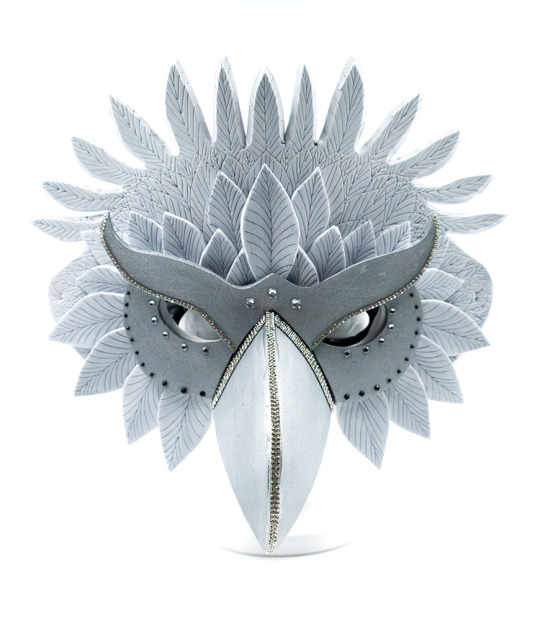





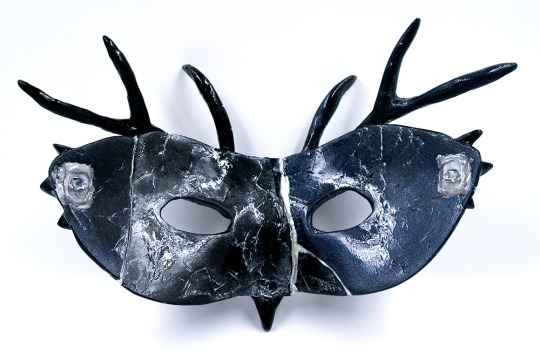


Experimental Final - Masquerade Masks
For the experimental I created a set of 2 masks: One that represents the outer persona we put on for others, and the other representing the inner self we hide. The outer mask sits on top of the other while also hiding it. The 2 masks are opposites in appearance, idea and process.
The concept of the masks were inspired by Jungian archetypes, mainly the Persona and also partially Shadow. Persona is about how we put on a social 'mask' to present ourselves a certain way. Our conscious ego is a mask we put on to fit in to social norms, hiding the parts of ourselves which may be deemed 'unacceptable' by society. The Shadow represents our unconscious self, the parts of ourselves that we repress based on social norms or even our own morals. It is a wild and unknown 'darker' side to our psyche which sometimes takes on the appearance of monsters, dragons or snakes in our dreams. Carl Jung believed there needs to be harmony between the conscious and unconscious.
The inner mask was also inspired by Kintsugi, which is the Japanese art of repairing pottery with lacquer mixed or dusted with gold or silver, making the cracks stand out. The principle of Kintsugi embraces imperfection or flaws rather than hiding it. The metallic repaired cracks highlights its history and how it was accepted and overcome. This can also relate to trauma with how we must learn to accept and understand in the healing process.
Both the masks are also inspired by masquerade masks, where the purpose of them is the disguise the wearer, hiding their identity. The idea is to have 2 masks, with one sitting on top of the other, hiding the inner mask's appearance. The outer mask
The outer mask's appearance is mostly white and monochrome with a bird-like appearance. The bird imagery was inspired by how birds have gorgeous plumages as part of their courtship displays to attract mates. The materials used are foam, acrylic paint and cheap fake crystals. The mask looks pretty at a glance, but when taking a closer look, one may notice the cheap materials. It represents how we present a façade to others to be accepted and liked, disguising or true self.
The process of this mask was very easy with little to no trouble, and did not take long to make. Texture in the fake feathers and crystals are added to distract from any flaws on the mask. Nothing is added to the backside since the purpose is to present a persona on the outside.
The inner mask is the opposite. It is black with a dragon-like appearance. The imagery takes inspiration from both Western and Eastern dragons. Western dragons are considered monstrous and symbolize destruction while Eastern ones represent wisdom, strength and great fortune. The mask is made up of pieces of resin and Sculpey clay. A piece of the broken clay is included to visualize the genuine self. This is the real deal, their true self. The resin is not fully opaque as evidenced when holding it to a light, revealing the true self. The resin is also mixed with black, blue, purple mica and silver flakes, their 'true colours' compared to the desaturated outer mask. The cracks and wrinkles are highlighted by silver paint and mica powder to embrace the imperfections. There is also some weight to this mask, making it feel more genuine compared to the foam one. The message of this mask is to accept and embrace your 'flaws' rather than try to hide them.
The process of this mask was the opposite of the outer one. This one took a lot longer to do due to being a learning process and experimenting with resin, molds and other materials. This was my first time working with resin so I experimented with mixing different things to see what would work before making the final pieces. It feels like every step something would go wrong. Through the pain and trouble I myself needed to learn to accept the imperfections during the process.
0 notes
Text
Website : https://www.finessemediums.co.nz
Address : Auckland, New Zealand
Finesse Mediums, based in Auckland, New Zealand, specializes in providing a wide range of polymer clay art supplies for artists, crafters, and jewelry makers. With a focus on quality and affordability, they offer textures, silkscreens, findings, charms, molds, and more. Catering to both local and international customers, they ensure quick delivery times and offer free shipping on larger orders. Their commitment to customer satisfaction is evident in their responsive customer service and willingness to incorporate customer feedback into their product selection.
Instagram : https://www.instagram.com/finessemediums/
Keywords:
clay sculpting tools
jewelry making with clay
pottery clay for sale
craft supplies store
handcrafted polymer clay jewelry
silkscreens for polymer clay
clay sculpting techniques
clay sculptures for sale
clay pottery supplies
clay modeling supplies
clay earrings online
polymer clay jewelry sets
polymer clay online store
clay charms for sale
polymer clay techniques
polymer clay creations for sale
clay art supplies nz
jewelry making materials australia
clay textures international
silkscreens for clay crafting
clay findings online
clay molds for artists
clay jewelry components
clay crafting materials
clay beads for jewelry
clay artistry online store
clay workshops international
clay tutorials for artists
polymer clay creations australia
clay art projects for sale
custom clay pieces nz
clay art tools online
clay design materials
clay artistry supplies australia
clay jewelry components international
clay art innovations online
polymer clay online tutorials
clay crafting ideas australia
clay artistry workshops nz
unique clay textures online
handmade silkscreens for clay
custom clay charms for sale
polymer clay molds online
clay findings and components
craft supplies for artists
clay jewelry online store
polymer clay crafting materials
clay earrings and beads
artistic clay sculptures online
online clay artistry store
international clay workshops
clay tutorials and techniques
handmade polymer clay creations
clay art projects for artists
custom clay pieces for sale
innovative clay art tools
clay modeling materials online
unique clay design components
artistry supplies for clay
clay jewelry components store
clay artistry innovations
polymer clay tutorials online
clay crafting ideas and projects
clay jewelry making materials
polymer clay art workshops
unique clay textures for sale
custom clay charms online
polymer clay molds and tools
clay findings and components store
artistic craft supplies online
unique clay jewelry components
clay sculpting tools and materials
polymer clay artistry store
clay workshops and tutorials
clay art projects and ideas
custom polymer clay pieces online
innovative clay art tools and materials
clay modeling techniques for artists
handmade clay textures online
silkscreens for artistic clay projects
custom clay charms and beads
polymer clay molds and textures
craft supplies for clay artistry
clay jewelry components for sale
clay artistry innovations online
polymer clay tutorials and techniques
unique clay jewelry making materials
polymer clay artistry workshops
innovative clay textures for sale
handmade silkscreens for polymer clay
custom polymer clay charms online
unique silkscreen tools for clay
custom charms and links collection
artistic clay embellishments shop
vibrant polymer clay creations store
personalized clay transfers online
silkscreen tools for clay artistry
unique polymer clay mold options
foil techniques for creative clay
vibrant polymer clay jewelry pieces
creative liquid clay accessory set
creative liquid clay accessory collection
handmade clay texture mold assortment
exclusive jewelry findings and links set
decorative posts for unique clay artistry
unique clay texture mold assortment
personalized clay transfer essentials kit
quality micas and glitters set for sale
alcohol inks and finishing tools assortment
bespoke polymer clay mold collection for sale
foil techniques for personalized clay art
vibrant polymer clay jewelry assortment online
creative liquid clay accessory collection for sale
handmade clay texture mold assortment for sale
exclusive jewelry findings and links set online
#creative liquid clay accessory collection#handmade clay texture mold assortment#exclusive jewelry findings and links set#decorative posts for unique clay artistry#unique clay texture mold assortment#personalized clay transfer essentials kit#quality micas and glitters set for sale#alcohol inks and finishing tools assortment#bespoke polymer clay mold collection for sale#foil techniques for personalized clay art#vibrant polymer clay jewelry assortment online#creative liquid clay accessory collection for sale#handmade clay texture mold assortment for sale#exclusive jewelry findings and links set online
1 note
·
View note
Text

Today I plan on going rock hunting with the halfling prince. My hopes are to find a buttload more flakes of mica for marble making in the future. I had no idea this area was going to be so abundant in flakes, otherwise I would have brought my surveying kit! Next time I know to bring it if heading to Maine.
Hopefully we find a huge chonky rock for our collection! It would be super cool to make a sphere out of one. Would make this trip super worth it, and memorable! Even so, I'm having a lot of fun!
My boyfriend who does pottery would probably like some of this mica as well... Hmm... I should probably find a better way to store all of this. Keeping them between some cool leaves I found does not seem the most optimal as time progresses.
#Zezah Xenobia Citrine I#Marbles#Mica#Rocks#Drinking so much coffie that I see the world in slowmoe#Travel
0 notes
Text
Exploring Arts and Crafts Home Design Concepts!

In the world of interior design, the Arts and Crafts movement has left an indelible mark. With its emphasis on craftsmanship, simplicity, and natural beauty, Arts and Crafts home design continues to captivate homeowners and designers alike. In this blog post, we will delve into the fascinating world of Arts and Crafts home design concepts, exploring its origins, key elements, and how you can incorporate this timeless aesthetic into your own living space.
Origins of Arts and Crafts Home Design
The Arts and Crafts movement emerged in the late 19th century as a reaction against the mass production and industrialization of the Victorian era. It sought to revive traditional craftsmanship and celebrate the inherent beauty of natural materials. Inspired by the writings of John Ruskin and the ideas of William Morris, the movement advocated for handmade objects and a return to simplicity and authenticity.
Key Elements of Arts and Crafts Home Design
Natural Materials: A hallmark of Arts and Crafts design is the use of natural materials such as wood, stone, and glass. These materials are celebrated for their inherent beauty, and their incorporation into home design creates a warm and inviting atmosphere.
Handcrafted Details: The emphasis on craftsmanship is central to Arts and Crafts design. Intricate woodworking, hand-carved furniture, and artisanal metalwork are common features that add a touch of uniqueness and personality to each piece.
Simple and Functional Layouts: Arts and Crafts homes typically have an open and functional layout that prioritizes ease of movement and practicality. Rooms flow seamlessly into one another, allowing for a harmonious and cohesive living experience.
Earthy Color Palettes: The color palette in Arts and Crafts design draws inspiration from nature. Warm earth tones, such as deep browns, rich greens, and rusty oranges, are frequently used to create a cozy and serene ambiance.
Stylized Nature Motifs: Arts and Crafts design often incorporates stylized depictions of nature, such as botanical motifs, floral patterns, and wildlife-inspired artwork. These elements bring a sense of tranquility and connection to the natural world.
Incorporating Arts and Crafts Design in Your Home
Architectural Details: If you're fortunate enough to live in an Arts and Crafts-style home, make sure to highlight its architectural details. Showcase exposed beams, decorative woodwork, and stained glass windows to truly capture the essence of the movement.
Furniture and Lighting: Invest in handcrafted furniture pieces that feature clean lines, sturdy construction, and beautiful woodwork. Look for pieces with inlaid details, decorative hardware, and natural finishes. Complement your furniture with lighting fixtures inspired by the Arts and Crafts aesthetic, such as mica lampshades or hammered metal pendants.
Textiles and Upholstery: Incorporate Arts and Crafts design principles through your choice of textiles and upholstery. Opt for natural fabrics like linen or cotton in earthy hues, and look for patterns that feature botanical motifs or geometric designs.
Art and Accessories: Enhance your space with carefully selected art and accessories that reflect the Arts and Crafts style. Display nature-inspired artwork, handmade pottery, and decorative pieces with organic forms. Consider incorporating textiles like woven rugs or tapestries for added texture and warmth.
Outdoor Spaces: Extend the Arts and Crafts aesthetic to your outdoor spaces. Create a welcoming porch with Craftsman-style furniture and planters filled with native plants. Incorporate natural stone pathways and incorporate landscape elements that blend seamlessly with the surrounding environment.
Conclusion
Exploring Arts and Crafts home design concepts allows us to reconnect with the beauty of craftsmanship, simplicity, and nature. By incorporating natural materials, handcrafted details, and a warm color palette, you can create a timeless and inviting living space. Whether you live in an Arts and Crafts-style home or simply wish to infuse elements of this aesthetic into your current space, embracing Arts and Crafts design concepts will undoubtedly bring a sense of authenticity and tranquility to your home.
0 notes
Text

. The artist I assign to this assignment is. Ed Hardy 1995 Tweeter's Recovery. The five facts about the artwork are
o The artwork was created in 1995, shortly after Don Ed Hardy completed his addiction treatment.
o Hardy's own experience of recovery inspired the artwork.
o The artwork has been interpreted as a symbol of hope and resilience.
o The artwork is currently on display at the Fine Arts Museums of San Francisco.
o The artwork is part of the museum's permanent collection of prints and drawings.
Don Ed Hardy created the artwork in 1995, shortly after completing his addiction treatment.
When I first saw this artwork, I saw it as a powerful symbol of resilience and recovery. The bird struggles against the elements but is determined to reach its destination.
The symbols of hope and healing suggest that the bird will eventually succeed in its quest. The Red represents passion and courage, contrasted with blue and green in a stormy sea. The crown of thorns represents Christ's suffering, while the halo symbolizes holiness. The figure with a glowing hand signifies divine guidance. I still hold the same opinion after reading the author's artwork description. The artwork is a personal statement by Don Ed Hardy, and he has explained that the bird in the artwork symbolizes his journey through overcoming addiction. It serves as a reminder that no matter how difficult things may seem, there is always hope and a way to overcome adversity.
The art that I selected is that's vast. It's important to me because that was the first art that I created when I knew art was a sort of therapist to meA type of soil material called clay is made up of fine-grained minerals and has a high water content, which gives it a malleable and moldable nature. It can be found in a variety of colors, ranging from white, grey, and brown to red, yellow, and green, and is often generated by the weathering and erosion of rocks like feldspar and mica.
Ask
Numerous industries, including ceramics, building, agriculture, and cosmetics, frequently employ clay.
Due to its flexibility and capacity to maintain its shape when burnt, it is utilized in ceramics to create pottery, bricks, and tiles. Clay is used in construction to make adobe bricks, which are frequently employed in structures in regions with hot, dry conditions. I didn't use any media since I was exploring on my own yes, I find it beautiful because that's why my first try and I think I did okay and even perfection is not perfect.
The step taking
Collecting the clay.
Kneading the clay after removing any small stones.
Shaping the pot using a pot wheel.
Heating the pot to make it hard.
Decorating the pot if needed.
Reheating the pot to make the decoration stick to the pot.


Hello there! My name is Taisha, and I am a 22-year-old female who loves art, singing, and traveling. I am from Haiti and can speak three languages. When I am not having fun, I enjoy singing and painting. I believe that life is meant to be lived to the fullest, and I am doing just that! Follow me on my adventures for some inspiration.


1 note
·
View note
Text
WHAT IS BALL CLAY AND HOW IS IT USED AND APPLIED IN DIFFERENT INDUSTRIES LIKE CERAMIC?
The demand for high-quality clay, well suited to the creation of the desired ceramic material, is ubiquitous given the widespread usage of ceramic materials. In addition to supplying and processing the widest variety of clay materials, African Pegmatite also offers an unwavering assortment of minerals of exceptional quality, making it an ideal industrial partner for any endeavour.
Ceramics may be found in just about every aspect of daily life, from the bricks used in construction to the tiles in the bathroom to the plates and bowls on which the world's population feasts and washes. Pottery making dates back thousands of years. Clay is used in a variety of modern handicrafts, from those made by trained artists to those made in the home.
The term "ceramic" refers to a wide variety of manmade and naturally occurring substances, including but not limited to glass, bricks, cement, pottery, porcelain, stoneware, earthenware, graphite, and diamond. Ceramic, in the simplest terms, refers to anything created by firing clay.
Different types of clay may be distinguished from one another based on their geological origin and the required firing temperature to provide maximum strength and durability. So let’s check what is ball clay and where you can find the best ball clay in India.
What is Ball Clay?
Ball clay is quite malleable, and it has very little mineral impurities. It is always suggested to inquire about ball clay supplier in India and quality of their product before considering them for your business needs. The material's condition determines the hue it takes on. Typically, they are a dark grey while wet but a pale grey or white when burnt. They don't require as high of a firing temperature as porcelain clays (1,280 °C) to reach their full hardness.
Because of their extreme shrinkage when dried or fried, ball clays are rarely useful on their own. When combined with other clays, however, such as porcelain, they gain a remarkable amount of workability and plasticity and become incredibly useful. Ball clays are well-known for their rheological stability and their pale tint after curing. They may be used with stoneware clays to create an entirely different aesthetic.
Ball clay in India is widely sought after because of its many valuable applications in the pottery, tile, and sanitaryware industries. Kaolinite accounts for 20%-80% of the weight of ball clays, while mica makes for 10%-25% and quartz sand or other accessory minerals make up the rest. The grain size of ball clays is often quite small.
How Ball Clay got its name
In the early days after its discovery, specialised hand tools were used to extract ball clay. About 30-centimeter cubes were clumped with one another. The'sticky' quality of the material allowed the cubes to maintain their form. However, they were rolled while being transported. As a result, the clay fragments lost their sharp edges, becoming round balls instead. It is also known as plastic clay in some regions because of its malleability.
Where may ball clay be used?
Tobacco pipes, one of the first applications of ball clay, dating back to prehistoric times. Ball clay's physical and chemical qualities were once underappreciated, but today they are used in a wide range of products.
1. Ceramics: Due to its great flexibility and strength, as well as its white-firing qualities, ball clay is the most crucial ingredient in ceramic production. Many types of ceramics, such as dishware and utensils, rely on their combination with other materials.
2. Refractory Clays: Ball clays are stable at very high temperatures without affecting their chemical makeup. That's why you'll find them in things like kiln insulation and other refractory goods everywhere.
3. Tile Production: Because of its malleability and high binding strength, ball clay in India is perfect for making tiles. Tiles are made with it and other materials including talc, feldspar, silica, and kaolin.
4. Electrical Insulators: Ball clays, in addition to being resistant to heat, are also great insulators. That's why they're so common in the manufacturing of porcelain insulators and other forms of electrical insulation.
5. Other Applications: In addition to these primary uses, ball clays have a wide variety of secondary applications in the fields of building, agriculture, and horticulture. Plastics, sealants, polymers, and even fertilisers all employ it as a filler ingredient.
Conclusion
Although it was formerly a mineral only found in a few locations, ball clay is now essential to modern life. Ball clay from Zillion Sawa Minerals Pvt. Ltd.- one of the top ball clay supplier in India is used to make everything from building materials to ceramics to electrical components. Ball clays, in the technical sense, are fine-grained clays that are both pliable and strong. Ball clay has been used since Roman times, and there have been many advancements in the mining, processing, and usage of this material since then.
1 note
·
View note
Text
High-Quality Silica Sand Suppliers for Industrial Applications
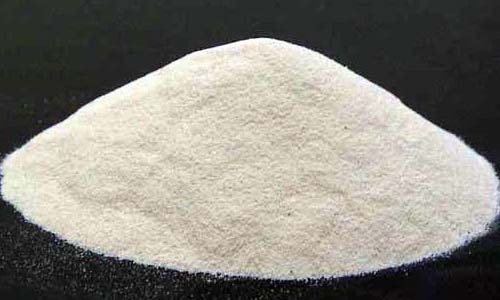
Silica sand is a naturally occurring granular material composed of quartz and other minerals. High-quality silica sand is a crucial raw material used in a wide range of industrial applications. From glass production to foundry casting and hydraulic fracturing, silica sand plays a critical role in various manufacturing processes. As a leading supplier of silica sand, Pratibha Refractory is committed to delivering high-quality products and customized solutions to meet the unique needs of our clients. Silica sand is primarily composed of quartz, which is the most common mineral on Earth. It also contains other minerals, including feldspar, mica, and iron oxides, which can affect its color and properties. The purity and consistency of silica sand are critical in many industrial applications. High-quality silica sand should have a minimum silica content of 99%, low impurities, and a specific grain size and shape.
Industrial Applications of Silica Sand
Glass Production: Silica sand is the primary raw material used in glass production. It is mixed with other ingredients, such as soda ash, limestone, and feldspar, to create a glass batch. The high purity and consistency of silica sand are crucial to achieving the desired properties of the glass, including clarity, strength, and durability.
Foundry Casting: Silica sand is used as a molding material in foundry casting. It is mixed with a binder to create a mold that can withstand the high temperatures and pressures of metal casting. The high-quality silica sand is essential in ensuring the accuracy and precision of the cast parts.
Hydraulic Fracturing: Silica sand is used as a proppant in hydraulic fracturing. It is added to the fracturing fluid to keep the fractures open and allow the oil and gas to flow to the wellbore. The high-quality silica sand with specific grain size and shape is crucial to ensure the effectiveness of the fracturing process.
Construction: Silica sand is used in construction as a filler in concrete and mortar. It helps improve the strength and durability of the structures and can also improve the workability of the mix.
Water Filtration: Silica sand is used as a filtration medium in water treatment. It is effective in removing suspended solids, turbidity, and other impurities from water.
Abrasive Blasting: Silica sand is used as an abrasive material in sandblasting. It is effective in removing paint, rust, and other coatings from surfaces.
Ceramics: Silica sand is used in the production of ceramics, such as porcelain, pottery, and stoneware. It is used as a raw material in the clay mixture and can affect the properties of the final product.
Why Work with Pratibha Refractory as Your Silica Sand Supplier?
Quality: At Pratibha Refractory, we understand the critical role that high-quality silica sand plays in industrial applications. We source our raw materials from reputable mines and use advanced processing techniques to ensure that our silica sand meets the highest quality standards.
Customization: We understand that different industries have different requirements when it comes to silica sand. That's why we offer customized solutions to meet your specific needs. We can provide silica sand with specific grain sizes, shapes, and purity levels to ensure the optimal performance of your processes.
Reliability: As a trusted and experienced supplier, we are committed to delivering our products on time and in the right quantities. Our extensive supply chain network and efficient logistics ensure that you get your silica sand when you need it.
Technical Support: Our team of experts is always available to provide technical support and guidance on the use of silica sand in your processes. We can help you optimize your processes and achieve the desired outcomes.
Are you in need of high-quality silica sand for your industrial applications? Look no further than Pratibha Refractory, your trusted supplier of premium silica sand. Contact us today to discuss your specific requirements and see how our silica sand can improve the efficiency and effectiveness of your processes. Don't settle for subpar materials – choose Pratibha Refractory for reliable and consistent silica sand that meets your exact specifications.
0 notes